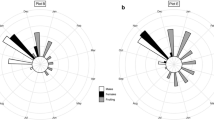Summary
Females and males of three tree species did not differ in growth or mortality over an interval of 9.5 years. Comparing between sexes and across species, there was no consistent pattern of effects of short-term (1 year) growth and fecundity on longer-term gorwth or mortality. Effects of size were significant (but minor) for growth in one species, and were significant for mortality in two species. Soil type affected mortality in one species, but affected growth in all three species. Sex and size are not consistently strong bases for predicting the performance of adult trees.
Similar content being viewed by others
References
Ackerly DD, Rankin-de-Merona JM, Rodrigues WA (1990) Tree densities and sex ratios in breeding populations of dioecious central Amazonian Myristicaceae. J Trop Ecol 6:239–248
Alliende MC, Harper JL (1989) Demorgraphic studies of a dioecious tree. I. Colonization, sex and age structure of a population of Salix cinerea. J Ecol 77:1029–1047
Armstrong JE, Irvine AK (1989) Flowering, sex ratios, pollen-ovule ratios, fruit set, and reproductive effort of a dioecious tree Myristica insipida (Myristicaceae), in two different rain forest communities. Am J Bot 76:74–85
Bawa KS, Webb CJ (1984) Flower, fruit and seed abortion in tropical forest trees. Am J Bot 71:736–751
Bourgeois WM, Cole DW, Riekerk H, Gessel SP (1972) Geology and soils of comparative ecosystems study areas, Costa Rica. (Contrib. 11) Inst. Forest Products, Univ. Washington, Scattle, WA, USA
Bullock SH (1982) Population structure and reproduction in the Neotropical dioccious tree Compsoneura sprucei. Oecologia 55:238–242
Bullock SH, Bawa KS (1981) Sexual dimorphism and the annual flowering pattern of Jacaratia dolichaula (D. Smith) Woodson (Caricaceae) in a Costa Rican rain forest. Ecology 62:1494–1504
Bullock SH, Beach JH, Bawa KS (1983) Episodic flowering and sexual dimorphism in Guarea rhopalocarpa in a Costa Rican rain forest. Ecology 64:851–861
Clark DB, Clark DB (1984) Spacing dynamics of a tropical rain forest tree: evaluation of the Janzen-Connell model. Am Nat 124:769–788
Clark DB, Clark DA (1987) Population ecology and microhabitat distribution of Dipteryx panamensis, a Neotropical rain forest emergent tree. Biotropica 19:236–244
Clark DB, Clark DA (1988) Leaf production and the cost or reproduction in the neotropical rain forest cycad, Zamia skinneri. J Ecol 76: 1153–1163
Córdova-Casillas B (1985) Demografía de árboles tropicales. In: Gómez-Pompa A, Del Amo-Rodríguez S (eds) Investigaciones sobre la regeneración de selvas altas en Veracruz, México. Vol 2. Editorial Alhambra, México, México, pp 103–128
Day RW, Quinn GP (1989) Comparison of treatments after an analysis of variance in ecology. Ecol Monogr 5:433–463
Enright N, Ogden J (1979) Applications of transition matrix models in forest dynamics: Araucaria in Papua New Guinea and Nothofagus in New Zealand. Aust J Ecol 4:3–23
Grant MC, Mitton JB (1979) Elevational gradients in adult sex ratios and sexual differentiation of growth rates of Populus tremuloides Michx. Evolution 33:914–918
Hartshorn GS (1978) Tree falls and tropical forest dynamics. In: Tomlinson PB, Zimmermann MH (eds) Tropical trees as living systems. Cambridge Univ Press, Cambridge, UK, pp 617–638
Janzen DH (1989) Natural history of a wind-pollinated Central American dry forest legume tree (Ateleia herbert-smithii Pittier). In: Stirton CH, Zarucchi JL (eds) Advances in legume biology. Monogr Syst Bot Missouri Bot Gard 29:293–376
Jones D, Matloff N (1986) Statistical hypothesis testing in biology: a contradiction in terms. J Econ Entomol 79:1156–1160
Lieberman D, Lieberman M, Hartshorn G, Peralta R (1985a) Growth rates and age-size relationships of tropical wet forest trees in Costa Rica. J Trop Ecol 1:97–109
Lieberman D, Lieberman M, Peralta R, Hartshorn GS (1985b) Mortality patterns and stand turnover rates in a wet tropical forest in Costa Rica. J Ecol 73:915–924
Lloyd DG, Webb CJ (1977) Secondary sex characters in plants. Bot Rev 43:177–216
Mata-Chávez R, Sancho F (1987) Mapa de estudio detallado de suelos. Organización para Estudios Tropicales, Estación Biológica La Selva
Meagher TR (1982) The population biology of Chamaelirium luteum, a dioecious member of the lily family: two-sex population projection and stable population structure. Ecology 63:1701–1711
Mueller-Dombois D (1988) Toward a unifying theory of stand-level dieback. Geojournal 17:249–251
Opler PA, Bawa KS (1978) Sex ratios in some tropical forest trees. Evolution 32:812–821
Ornduff R (1990) Geographic variation in reproductive behavior and size structure of the Australian cycad Macrozamia communis (Zamiaceae). Am J Bot 77:92–99
Popp JW, Reinartz JA (1988) Sexual dimorphism in biomass allocation and clonal growth of Xanthoxylum americanum. Am J Bot 75:1732–1741
Rodríguez y Pacheco AA, Barrio Chavira JM (1979) Desarrollo de caoba (Swietenia humilis King) en diferentes tipos de suelos. Cienc For 4(22):45–64
Sakai AK, Burris TA (1985) Growth in male and female aspen clones: a twenty-five-year longitudinal study. Ecology 66:1921–1927
Sarukhán J, Piñero D, Martínez-Ramos M (1985) Plant demography: a community level interpretation. In: White J (ed) Studies on plant demography. Academic Press, London, UK, pp 17–35
Schulze ED (1982) Plant life forms and their carbon, water and nutrient relations. In: Lange OL, Nobel PS, Osmond CB, Ziegler H (eds) Plant physiological ecology II. Water relations and carbon assimilation. Springer-Verlag, Berlin, Germany, pp 615–676
Swaine MD, Lieberman D, Putz FE (1987) The dynamics of tree populations in tropical forest: a review. J Trop Ecol 3:359–366
Warming JEB (1909) Oecology of plants: an introduction to the study of plant communities. Clarendon Press, Oxford, UK
Willson MF (1986) On the costs of reproduction in plants: Acer negundo. Am Midl Nat 115:204–207
Author information
Authors and Affiliations
Rights and permissions
About this article
Cite this article
Bullock, S.H. Effects of sex, size and substrate on growth and mortality of trees in tropical wet forest. Oecologia 91, 52–55 (1992). https://doi.org/10.1007/BF00317240
Received:
Accepted:
Issue Date:
DOI: https://doi.org/10.1007/BF00317240




